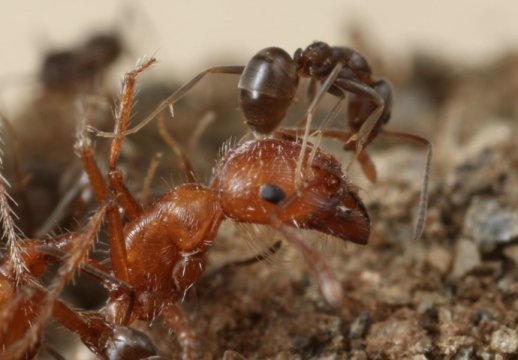For global invasion, Argentine ants use chemical weapons Compounds produced by Argentine ants are used to recruit nestmates and incapacitate opponents
University of California - Riverside
Summary:
Researchers show how Argentine ants use chemical secretions as weapons in their interactions with harvester ants, which are native to California. The findings could help in the development of new pest control strategies

Using an action called gaster bending, Argentine Ants dab irritant chemicals onto their opponent's body.
Credit: University of California, Riverside
From their native home on the banks of South America's Paraná River, Argentine ants have conquered six continents and many oceanic islands. Their success is explained by several factors: they have more than one queen per colony, making them difficult to eradicate, and they adapt to changes in their environments by living transiently rather than building permanent nests.
Argentine ants are also highly aggressive, out-competing existing ant species for food and other resources. In a paper published today in Scientific Reports, researchers at the University of California, Riverside show how Argentine ants use chemical secretions as weapons in their interactions with harvester ants, which are native to California. The findings could help in the development of new pest control strategies.
Although they originated in a tropical ecosystem, Argentine ants are a major nuisance in California and the southern U.S., where they thrive in urban areas with artificial irrigation. They also pose natural and economic threats, competing with native ants and pollinators, and protecting plant pests such as aphids and scales in return for the sweet honeydew secretions that these insects produce.
Like many social insects, Argentine ants communicate via an assortment of chemicals that they excrete from their gaster (abdomen). During aggressive interactions, Argentine ants exhibit a behavior called gaster bending, where they place the tip of their gaster onto their opponent's body. Based on behavioral observations, researchers have long inferred that, during this interaction, Argentine ants may spray or dab irritant chemicals onto their opponent's body.
The UCR researchers confirmed this experimentally, showing that Argentine ants produce secretions containing two compounds (dolichodial and iridomyrmecin), which they apply to the surface of harvester ants during aggressive interactions. The research was led by Dong-Hwan Choe, an assistant cooperative extension specialist and assistant professor of entomology in UCR's College of Natural and Agricultural Sciences.
Choe's team investigated the effect of these compounds on harvester ants, showing they caused both irritation and disorientation. The compounds also attracted other Argentine ants to the area, allowing them to mount a larger, coordinated response to the native ant species.
"This research finding experimentally verified the long-held assumption that Argentine ants use gaster-produced compounds during aggressive interactions with other ant species. They use these compounds not only for incapacitating the opponent, but also for calling more nestmates from nearby locations for their help in combat," Choe said.
Choe said synthetic versions of these chemicals could be used to develop new pest management strategies with a greater selectivity.
"Potentially, these compounds could be used in a bait to attract Argentine ants toward a poison while at the same time acting as a deterrent to harmless native ants," he said.
Story Source:
Materials provided by University of California - Riverside.